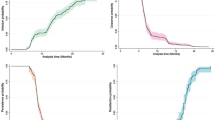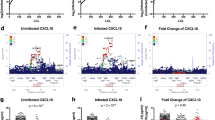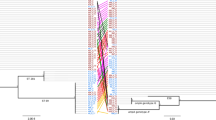Abstract
Experimental evidence implicates interferon gamma (IFNγ) in protection from and resolution of chlamydial infection. Conversely, interleukin 10 (IL10) is associated with susceptibility and persistence of infection and pathology. We studied genetic variation within the IL10 and IFNγ loci in relation to the risk of developing severe complications of human ocular Chlamydia trachomatis infection. A total of 651 Gambian subjects with scarring trachoma, of whom 307 also had potentially blinding trichiasis and pair-matched controls with normal eyelids, were screened for associations between single-nucleotide polymorphisms (SNPs), SNP haplotypes and the risk of disease. MassEXTEND (Sequenom) and MALDI-TOF mass spectrometry were used for detection and analysis of SNPs and the programs PHASE and SNPHAP used to infer haplotypes from population genetic data. Multivariate conditional logistic regression analysis identified IL10 and IFNγ SNP haplotypes associated with increased risk of both trachomatous scarring and trichiasis. SNPs in putative IFNγ and IL10 regulatory regions lay within the disease-associated haplotypes. The IFNγ +874A allele, previously linked to lower IFNγ production, lies in the IFNγ risk haplotype and was more common among cases than controls, but not significantly so. The promoter IL10-1082G allele, previously associated with high IL10 expression, is in both susceptibility and resistance haplotypes.
This is a preview of subscription content, access via your institution
Access options
Subscribe to this journal
Receive 6 digital issues and online access to articles
$119.00 per year
only $19.83 per issue
Buy this article
- Purchase on Springer Link
- Instant access to full article PDF
Prices may be subject to local taxes which are calculated during checkout


Similar content being viewed by others
References
Thylefors B, Negrel AD, Pararajasegaram R, Dadzie KY . Global data on blindness. Bull World Health Organ 1995; 73: 115–121.
Schachter J, Dawson CR . The epidemiology of trachoma predicts more blindness in the future. Scand J Infect Dis Suppl 1990; 69: 55–62.
Mabey DC, Solomon AW, Foster A . Trachoma. Lancet 2003; 362: 223–229.
Bobo LD, Novak N, Munoz B, Hsieh YH, Quinn TC, West S . Severe disease in children with trachoma is associated with persistent Chlamydia trachomatis infection. J Infect Dis 1997; 176: 1524–1530.
West SK, Munoz B, Mkocha H, Hsieh YH, Lynch MC . Progression of active trachoma to scarring in a cohort of Tanzanian children. Ophthal Epidemiol 2001; 8: 137–144.
Mabey DCW, Hutin YJF, Bailey RL . The epidemiology and pathogenesis of trachoma. Rev Med Microbiol 1992; 3: 112–119.
Bailey RL, Holland MJ, Whittle HC, Mabey DC . Subjects recovering from human ocular chlamydial infection have enhanced lymphoproliferative responses to chlamydial antigens compared with those of persistently diseased controls. Infect Immun 1995; 63: 389–392.
Holland MJ, Bailey RL, Hayes LJ, Whittle HC, Mabey DC . Conjunctival scarring in trachoma is associated with depressed cell-mediated immune responses to chlamydial antigens. J Infect Dis 1993; 168: 1528–1531.
Wang S, Fan Y, Brunham RC, Yang X . IFN-gamma knockout mice show Th2-associated delayed-type hypersensitivity and the inflammatory cells fail to localize and control chlamydial infection. Eur J Immunol 1999; 29: 3782–3792.
Yang X, HayGlass KT, Brunham RC . Genetically determined differences in IL-10 and IFN-gamma responses correlate with clearance of Chlamydia trachomatis mouse pneumonitis infection. J Immunol 1996; 156: 4338–4344.
Yang X, Gartner J, Zhu L, Wang S, Brunham RC . IL-10 gene knockout mice show enhanced Th1-like protective immunity and absent granuloma formation following Chlamydia trachomatis lung infection. J Immunol 1999; 162: 1010–1017.
Beatty WL, Belanger TA, Desai AA, Morrison RP, Byrne GI . Tryptophan depletion as a mechanism of gamma interferon-mediated chlamydial persistence. Infect Immun 1994; 62: 3705–3711.
Igietseme JU, Ananaba GA, Candal DH, Lyn D, Black CM . Immune control of Chlamydial growth in the human epithelial cell line RT4 involves multiple mechanisms that include nitric oxide induction, tryptophan catabolism and iron deprivation. Microbiol Immunol 1998; 42: 617–625.
Ramsey KH, Sigar IM, Rana SV, Gupta J, Holland SM, Byrne GI . Role for inducible nitric oxide synthase in protection from chronic Chlamydia trachomatis urogenital disease in mice and its regulation by oxygen free radicals. Infect Immun 2001; 69: 7374–7379.
Burton MJ, Bailey RL, Jeffries D, Mabey DCW, Holland MJ . Cytokine and fibrogenic gene expression in the conjunctiva of subjects from a trachoma endemic Gambian community. Infect Immun 2004; 72: 7352–7356.
Holland MJ, Bailey RL, Conway DJ et al. T helper type-1 (Th1)/Th2 profiles of peripheral blood mononuclear cells (PBMC); responses to antigens of Chlamydia trachomatis in subjects with severe trachomatous scarring. Clin Exp Immunol 1996; 105: 429–435.
Bailey R, Fowler A, Peeling R et al. Lymphoproliferative responses to C. trachomatis EBs in a Gambian twin population; estimating the role of host genetic factors. In: Stephens RS, Byrne GI, Christiansen G et al (eds). Chlamydial Infections. International Chlamydia Symposium: San Francisco, USA, 1998, pp 474–477.
Mozzato-Chamay N, Corbett EL, Bailey RL, Mabey DC, Raynes J, Conway DJ . Polymorphisms in the IkappaB-alpha promoter region and risk of diseases involving inflammation and fibrosis. Genes Immun 2001; 2: 153–155.
Mozzato-Chamay N, Mahdi OS, Jallow O, Mabey DC, Bailey RL, Conway DJ . Polymorphisms in candidate genes and risk of scarring trachoma in a Chlamydia trachomatis-endemic population. J Infect Dis 2000; 182: 1545–1548.
Conway DJ, Holland MJ, Bailey RL et al. Scarring trachoma is associated with polymorphism in the tumor necrosis factor alpha (TNF-alpha) gene promoter and with elevated TNF-alpha levels in tear fluid. Infect Immun 1997; 65: 1003–1006.
Conway DJ, Holland MJ, Campbell AE et al. HLA class I and II polymorphisms and trachomatous scarring in a Chlamydia trachomatis-endemic population. J Infect Dis 1996; 174: 643–646.
Gabriel SB, Schaffner SF, Nguyen H et al. The structure of haplotype blocks in the human genome. Science 2002; 296: 2225–2229.
Bailey R, Osmond C, Mabey DC, Whittle HC, Ward ME . Analysis of the household distribution of trachoma in a Gambian village using a Monte Carlo simulation procedure. Int J Epidemiol 1989; 18: 944–951.
Newport MJ, Huxley CM, Huston S et al. A mutation in the interferon-gamma-receptor gene and susceptibility to mycobacterial infection. N Engl J Med 1996; 335: 1941–1949.
Altare F, Durandy A, Lammas D et al. Impairment of mycobacterial immunity in human interleukin-12 receptor deficiency. Science 1998; 280: 1432–1435.
Altare F, Ensser A, Breiman A et al. Interleukin-12 receptor beta1 deficiency in a patient with abdominal tuberculosis. J Infect Dis 2001; 184: 231–236.
Jouanguy E, Lamhamedi-Cherradi S, Lammas D et al. A human IFNGR1 small deletion hotspot associated with dominant susceptibility to mycobacterial infection. Nat Genet 1999; 21: 370–378.
Koch O, Awomoyi A, Usen S et al. IFNGR1 gene promoter polymorphisms and susceptibility to cerebral malaria. J Infect Dis 2002; 185: 1684–1687.
Henri S, Stefani F, Parzy D, Eboumbou C, Dessein A, Chevillard C . Description of three new polymorphisms in the intronic and 3′UTR regions of the human interferon gamma gene. Genes Immun 2002; 3: 1–4.
Chevillard C, Henri S, Stefani F, Parzy D, Dessein A . Two new polymorphisms in the human interferon gamma (IFN-gamma) promoter. Eur J Immunogenet 2002; 29: 53–56.
Bream JH, Carrington M, O'Toole S et al. Polymorphisms of the human IFNG gene noncoding regions. Immunogenetics 2000; 51: 50–58.
Ciccarone VC, Chrivia J, Hardy KJ, Young HA . Identification of enhancer-like elements in human IFN-gamma genomic DNA. J Immunol 1990; 144: 725–730.
Sica A, Tan TH, Rice N, Kretzschmar M, Ghosh P, Young HA . The c-rel protooncogene product c-Rel but not NF-kappa B binds to the intronic region of the human interferon-gamma gene at a site related to an interferon-stimulable response element. Proc Natl Acad Sci USA 1992; 89: 1740–1744.
Pravica V, Asderakis A, Perrey C, Hajeer A, Sinnott PJ, Hutchinson IV . In vitro production of IFN-gamma correlates with CA repeat polymorphism in the human IFN-gamma gene. Eur J Immunogenet 1999; 26: 1–3.
Pravica V, Perrey C, Stevens A, Lee JH, Hutchinson IV . A single nucleotide polymorphism in the first intron of the human IFN-gamma gene: absolute correlation with a polymorphic CA microsatellite marker of high IFN-gamma production. Hum Immunol 2000; 61: 863–866.
Beatty WL, Morrison RP, Byrne GI . Reactivation of persistent Chlamydia trachomatis infection in cell culture. Infect Immun 1995; 63: 199–205.
Beatty WL, Byrne GI, Morrison RP . Repeated and persistent infection with Chlamydia and the development of chronic inflammation and disease. Trends Microbiol 1994; 2: 94–98.
Morrison RP, Belland RJ, Lyng K, Caldwell HD . Chlamydial disease pathogenesis. The 57-kD chlamydial hypersensitivity antigen is a stress response protein. J Exp Med 1989; 170: 1271–1283.
Peeling RW, Bailey RL, Conway DJ et al. Antibody response to the 60-kDa chlamydial heat-shock protein is associated with scarring trachoma. J Infect Dis 1998; 177: 256–259.
Brunham RC, Peeling RW . Chlamydia trachomatis antigens: role in immunity and pathogenesis. Infect Agents Dis 1994; 3: 218–233.
Clark JG, Dedon TF, Wayner EA, Carter WG . Effects of interferon-gamma on expression of cell surface receptors for collagen and deposition of newly synthesized collagen by cultured human lung fibroblasts. J Clin Invest 1989; 83: 1505–1511.
Kurkinen M, Vaheri A, Roberts PJ, Stenman S . Sequential appearance of fibronectin and collagen in experimental granulation tissue. Lab Invest 1980; 43: 47–51.
Burton MJ, Holland MJ, Faal N et al. Which members of a community need antibiotics to control trachoma? Conjunctival Chlamydia trachomatis infection load in Gambian villages. Invest Ophthalmol Vis Sci 2003; 44: 4215–4222.
Solomon AW, Holland MJ, Burton MJ et al. Strategies for control of trachoma: observational study with quantitative PCR. Lancet 2003; 362: 198–204.
Dawson CR, Juster R, Marx R, Daghfous MT, Ben Djerad A . Limbal disease in trachoma and other ocular chlamydial infections: risk factors for corneal vascularisation. Eye 1989; 3 (Part 2): 204–209.
Gibson AW, Edberg JC, Wu J, Westendorp RG, Huizinga TW, Kimberly RP . Novel single nucleotide polymorphisms in the distal IL-10 promoter affect IL-10 production and enhance the risk of systemic lupus erythematosus. J Immunol 2001; 166: 3915–3922.
Turner DM, Williams DM, Sankaran D, Lazarus M, Sinnott PJ, Hutchinson IV . An investigation of polymorphism in the interleukin-10 gene promoter. Eur J Immunogenet 1997; 24: 1–8.
Eskdale J, Gallagher G, Verweij CL, Keijsers V, Westendorp RG, Huizinga TW . Interleukin 10 secretion in relation to human IL-10 locus haplotypes. Proc Natl Acad Sci USA 1998; 95: 9465–9470.
Crawley E, Kay R, Sillibourne J, Patel P, Hutchinson I, Woo P . Polymorphic haplotypes of the interleukin-10 5′ flanking region determine variable interleukin-10 transcription and are associated with particular phenotypes of juvenile rheumatoid arthritis. Arthritis Rheum 1999; 42: 1101–1108.
Kurreeman FA, Schonkeren JJ, Heijmans BT, Toes RE, Huizinga TW . Transcription of the IL10 gene reveals allele-specific regulation at the mRNA level. Hum Mol Genet 2004; 13: 1755–1762.
Westendorp RG, Langermans JA, Huizinga TW et al. Genetic influence on cytokine production and fatal meningococcal disease. Lancet 1997; 349: 170–173.
Lim S, Crawley E, Woo P, Barnes PJ . Haplotype associated with low interleukin-10 production in patients with severe asthma. Lancet 1998; 352: 113.
Llorente L, Richaud-Patin Y, Couderc J et al. Dysregulation of interleukin-10 production in relatives of patients with systemic lupus erythematosus. Arthritis Rheum 1997; 40: 1429–1435.
Kinnunen AH, Surcel HM, Lehtinen M et al. HLA DQ alleles and interleukin-10 polymorphism associated with Chlamydia trachomatis-related tubal factor infertility: a case–control study. Hum Reprod 2002; 17: 2073–2078.
Cohen CR, Plummer FA, Mugo N et al. Increased interleukin-10 in the endocervical secretions of women with non-ulcerative sexually transmitted diseases: a mechanism for enhanced HIV-1 transmission? AIDS 1999; 13: 327–332.
Lacraz S, Nicod LP, Chicheportiche R, Welgus HG, Dayer JM . IL-10 inhibits metalloproteinase and stimulates TIMP-1 production in human mononuclear phagocytes. J Clin Invest 1995; 96: 2304–2310.
Lim S, Roche N, Oliver BG, Mattos W, Barnes PJ, Chung KF . Balance of matrix metalloprotease-9 and tissue inhibitor of metalloprotease-1 from alveolar macrophages in cigarette smokers. Regulation by interleukin-10. Am J Respir Crit Care Med 2000; 162 (Part 1): 1355–1360.
Goddard KA, Hopkins PJ, Hall JM, Witte JS . Linkage disequilibrium and allele-frequency distributions for 114 single-nucleotide polymorphisms in five populations. Am J Hum Genet 2000; 66: 216–234.
Thylefors B, Dawson CR, Jones BR, West SK, Taylor HR . A simple system for the assessment of trachoma and its complications. Bull World Health Organ 1987; 65: 477–483.
Ackerman H, Usen S, Mott R et al. Haplotypic analysis of the TNF locus by association efficiency and entropy. Genome Biol 2003; 4: R24.
Griffin TJ, Smith LM . Single-nucleotide polymorphism analysis by MALDI-TOF mass spectrometry. Trends Biotechnol 2000; 18: 77–84.
Stephens M, Smith NJ, Donnelly P . A new statistical method for haplotype reconstruction from population data. Am J Hum Genet 2001; 68: 978–989.
Acknowledgements
We thank the study participants, field workers and laboratory staff at the Medical Research Council Laboratories in Gambia for their assistance. This work was supported by the Medical Research Council (UK).
Author information
Authors and Affiliations
Corresponding author
Rights and permissions
About this article
Cite this article
Natividad, A., Wilson, J., Koch, O. et al. Risk of trachomatous scarring and trichiasis in Gambians varies with SNP haplotypes at the interferon-gamma and interleukin-10 loci. Genes Immun 6, 332–340 (2005). https://doi.org/10.1038/sj.gene.6364182
Received:
Revised:
Accepted:
Published:
Issue Date:
DOI: https://doi.org/10.1038/sj.gene.6364182
Keywords
This article is cited by
-
Altered immune parameters associated with Koala Retrovirus (KoRV) and Chlamydial infection in free ranging Victorian koalas (Phascolarctos cinereus)
Scientific Reports (2019)
-
Conjunctival fibrosis and the innate barriers to Chlamydia trachomatis intracellular infection: a genome wide association study
Scientific Reports (2015)
-
Significant Roles Played by IL-10 in Chlamydia Infections
Inflammation (2014)
-
Innate immunity in ocular Chlamydia trachomatis infection: contribution of IL8 and CSF2 gene variants to risk of trachomatous scarring in Gambians
BMC Medical Genetics (2009)
-
Genetic variation at the TNF locus and the risk of severe sequelae of ocular Chlamydia trachomatis infection in Gambians
Genes & Immunity (2007)



